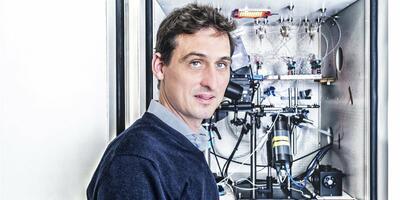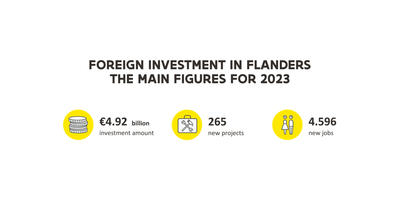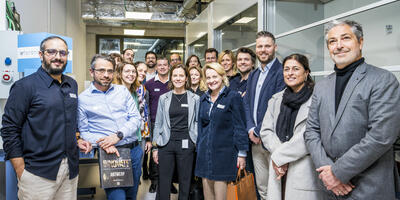
How Flanders’ brain tech scene combats brain disorders
How our brain works is still shrouded in mystery for the most part. A more in-depth understanding of the human brain is the holy grail not just for tackling diseases such as Alzheimer's and Parkinson's, but also for depression, addiction, burn-out, and many more. Luckily, breakthroughs in nanotech, neurobiology and computer algorithms are merging into ‘brain tech’, helping us unravel the mechanisms of the brain and better treat patients.
“Brain implants already help patients with epilepsy and Parkinson’s,” says Sebastian Haesler, director of NeuroElectronics Research Flanders (NERF). This interdisciplinary research center bundles the brain tech strengths of university KU Leuven and two of Flanders’ strategic research centers: VIB (life sciences) and imec (nano- and digital tech). What’s more, NERF is part of the vibrant neuroscience community around the Leuven Brain Institute, whose members include organizations such as the VIB-KU Leuven Center for Brain & Disease Research, the KU Leuven Departments of Neuroscience and Biology, and university hospital UZ Leuven. Let’s have a look behind the scenes!The most efficient computer
“Brain disorders are a massive problem,” explains NERF director Sebastian Haesler. “In Europe, the social costs related to brain disorders are higher than those for heart disease, cancer and diabetes combined. There have not yet been major advances in medication because we are still a long way from understanding the complexity of the brain. After all, the brain has over 86 billion neurons that are connected in a complex way. But one of the most fascinating observations is that our brain functions on barely 20 watts, making it by far the most efficient ‘computer’.”Despite the complexity, there has been substantial global investment in brain tech over the past few years to use technology to better understand brain activity and better treat sick people. The best-known example is Neuralink, the company of Tesla founder Elon Musk, which seeks to create a super connection between man and machine.Ready for big leaps in brain tech
Such far-reaching innovations may remain science fiction, but brain tech has been giving rise to an increasing number of innovative and vital applications. “For the first time, we’re ready to make big leaps,” confirms Haesler, who is conducting basic brain tech research on rodents along with his international, multidisciplinary team and hopes to translate that basic research into clinical research.“We are currently in the middle of three simultaneous revolutions,” he adds. “Firstly, there is the ongoing transition to ever-smaller hardware, at nanoscale, driven by advances in computer and smartphone technology. Secondly, neurobiology, the study of brain cells, has been making great headway over the past 10 to 15 years. This research field has been able to identify many of the important proteins, genes and cellular processes that make the human brain work. Thirdly, there’s an ongoing revolution in machine learning, which has enabled smart computer algorithms to recognize patterns in tons of brain data with increasing accuracy.”Mind-boggling applications
Due to these trends, brain tech is already being used in patients. “To give just one example, electrodes have already been placed into the brains of epilepsy patients,” says Haesler. “In addition, deep brain stimulation is being used to treat people suffering from Parkinson's disease. In this case, an electrode is integrated deep into a patient’s brain. That way, part of the brain can be stimulated, while suppressing the tremor typically associated with Parkinson’s. This method has been proven to work and has already been deployed to help some 150,000 patients.”“Neuroprosthesis is another promising application of brain technology,” Haesler continues. “Such implants make it possible for people who are no longer capable of moving to still control their arms, for instance, with their brain. This greatly improves their level of independence. Neuroprosthesis also benefits patients who are no longer able to speak by enabling them to control the cursor of a computer via their thoughts in order to communicate. It’s important to note, however, that such implants are currently still quite large and invasive, and they don't work for everyone.”Testing self-developed brain tech
As for Haesler and his team, they are testing self-developed brain tech on mice and rats to study their behavior. “Their brains are genetically very similar to ours,” explains Haesler. “A mouse’s reward system works the same way as that of humans. Every time you get something better than expected, dopamine neurons are activated, which have the same properties in humans and rodents.”“We train mice with a scent,” he continues. “Every time we release the scent, the mice receive sugar water. Because mice are smart and remember previous rewards, they already start licking their lips as soon as they smell the scent. That’s their dopamine system being activated. When people take drugs, for instance, that brain process gets hijacked. We want to get to the bottom of this fundamental process.”Furthermore, Haesler and his team developed a patented, wafer-thin micro-catheter system to introduce fluid into the brain: “We first tested it on mice by inserting the thin wire into their brains. At the end of the wire, there’s a 3D-printed piece of equipment containing pores that are 400 to 500 times smaller than a millimeter. As a result, you can introduce a fluid into the brain in a targeted and controlled manner.”Haesler hopes to use their patented system to achieve a breakthrough in the search for brain cancer treatment: “Today, there is no medication for terminal brain cancer. Some 95 to 98% of the available medication remains in the bloodstream and cannot penetrate the brain, but there may be medications that could work if you were to introduce them into the brain directly. Brain surgeons are quite open to our out-of-the-box technology. One day, we hope to test it in patients by introducing the micro-catheter during tumor removal surgery to administer medications directly into the brain. Whichever the outcome, though, it’s clear that we’re part of a brain tech ecosystem that can truly make a difference, together with university KU Leuven and university hospital UZ Leuven, among other organizations.”More high-tech, less invasive
Haesler and his team have even developed a more high-tech and less invasive technology: a wafer-thin, flexible film full of electronics that you can place on the brain. “I was inspired by the plastic displays I saw at imec, Flanders’ strategic research center for nanotech and digital innovation,” says Haesler. “The big advantage is that the industry was already investing heavily in that kind of production. If I’d had to start from scratch, it would take me 50 years.”Using the flexible film, which is non-toxic to humans, it’s possible to remotely control a large number of channels via one wire to activate brain cells. Haesler and his team are already testing it in rats and believe that they have found a good compromise for a longstanding dilemma in brain tech. Haesler: “The further from the brain the technology is introduced, the lower the quality of the signals from the neurons. This is the case, for instance, when electrodes are placed on a patient’s skull. The deeper you implant technology inside the brain, the better the signals, but such an approach is invasive. The thin film we developed – which should ideally be put on the brain instead of the skull – is not too invasive. But at the same time, it is sufficiently close to the brain to pick up electrical signals from neurons properly.”Haesler hopes the thin, flexible film will be ready for use within five to ten years: “My dream is that you can place it under the skin and use it to measure and stimulate brain activity. This would help create personalized treatments for psychiatric disorders. Patients could indicate how they are feeling on their smartphones, after which the self-learning system either intervenes or doesn’t, depending on the context. There would be a constant stream of feedback between the patient and the application.”“However,” Haesler emphasizes, “with brain tech, it’s like with all technology: you have to be careful about how you use it. The same goes for nuclear energy, for instance: you can use it to build a power plant or to make an atomic bomb.” In other words, ethical debates and up-to-date regulations are key to using any technology – brain tech included – in a truly beneficial way.Discover Flanders’ life sciences & health ecosystem
To say that Flanders has a diverse and innovation-driven business and research ecosystem for life sciences & health would be an understatement.Want to unravel this ecosystem in a virtual yet interactive way? Head to the Flanders360 platform and discover 300+ successful companies, universities, R&D centers, incubators and other players active in Flanders’ life sciences & health industry.Alternatively, check out our industry overview to learn more about the available tax, legal and other incentives for establishing your life sciences & health hub in Flanders.if(window.strchfSettings === undefined) window.strchfSettings = {};window.strchfSettings.stats = {url: "https://flanders-investment-trade.storychief.io/en/how-flanders-brain-tech-scene-combats-brain-disorders?id=2006029565&type=3",title: "How Flanders’ brain tech scene combats brain disorders",id: "94491510-e6b9-406d-ad01-a694fb226d49"};(function(d, s, id) {var js, sjs = d.getElementsByTagName(s)[0];if (d.getElementById(id)) {window.strchf.update(); return;}js = d.createElement(s); js.id = id;js.src = "https://d37oebn0w9ir6a.cloudfront.net/scripts/v0/strchf.js";js.async = true;sjs.parentNode.insertBefore(js, sjs);}(document, 'script', 'storychief-jssdk'))Reported by
Newspaper De Tijd


